笙泉8051单片机选型表
- 格式:pdf
- 大小:121.38 KB
- 文档页数:1
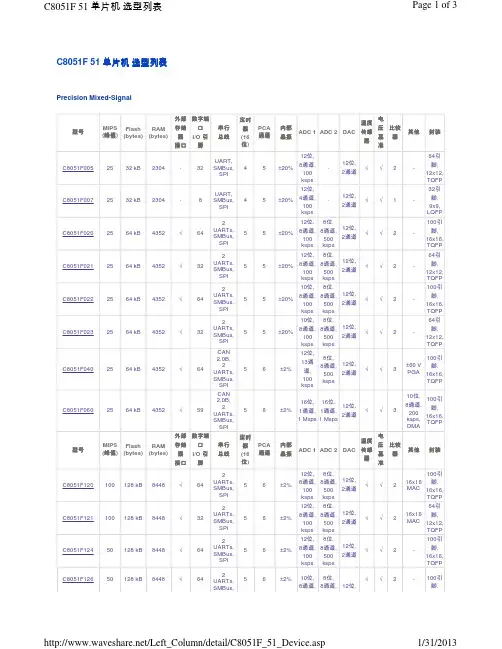
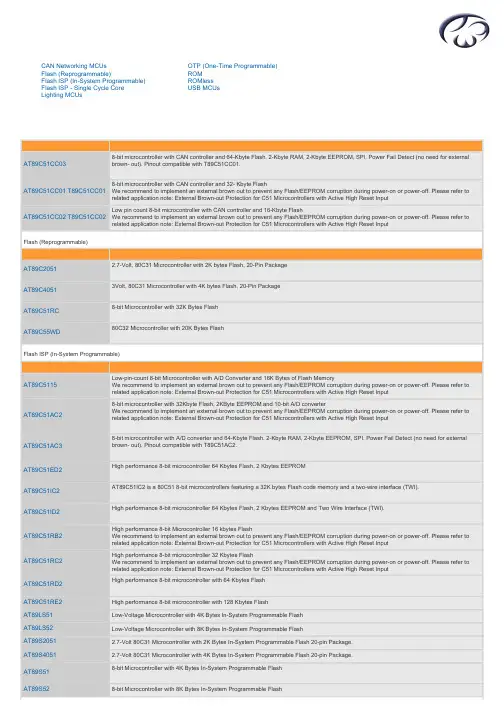
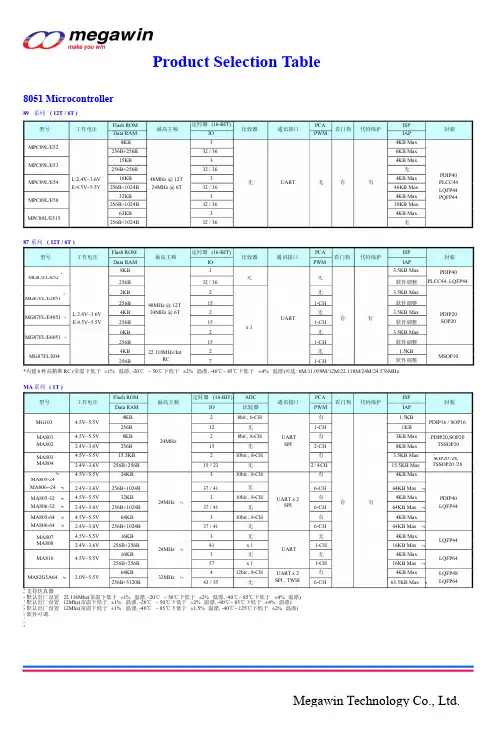
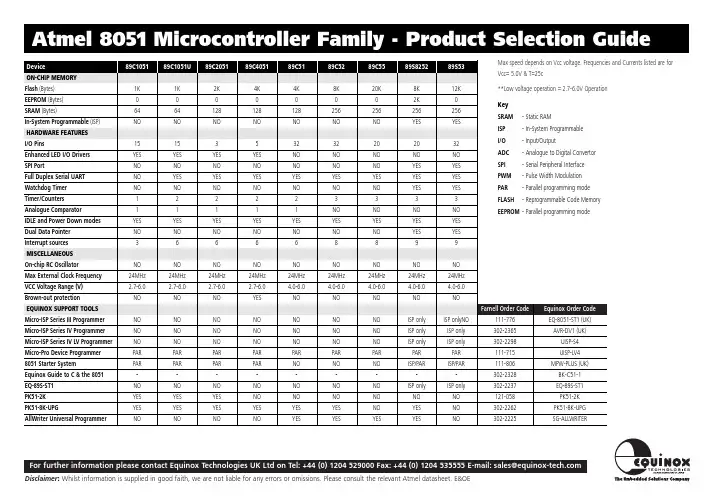
Continued....Features Array•Compatible with MCS-51™ Products•4K Bytes of Reprogrammable Flash Memory–Endurance: 1,000 Write/Erase Cycles• 3.0V to 6V Operating Range•Fully Static Operation: 0 Hz to 24 MHz•Two-Level Program Memory Lock•128 x 8-Bit Internal RAM•15 Programmable I/O Lines•Two 16-Bit Timer/Counters•Six Interrupt Sources•Programmable Serial UART Channel•Direct LED Drive Outputs•On-Chip Analog Comparator•Low Power Idle and Power Down Modes•Brown-Out DetectionDescriptionThe AT89C4051 is a low-voltage, high-performance CMOS 8-bit microcomputer with 4K Bytes of Flash programmable and erasable read only memory (PEROM). The device is manufactured using Atmel’s high density nonvolatile memory technology and is compatible with the industry standard MCS-51™ instruction set. By combining a versatile 8-bit CPU with Flash on a monolithic chip, the Atmel AT89C4051 is a pow-erful microcomputer which provides a highly flexible and cost effective solution to many embedded control applications.The AT89C4051 provides the following standard features: 4K Bytes of Flash, 128 bytes of RAM, 15 I/O lines, two 16-bit timer/counters, a five vector two-level interrupt architecture, a full duplex serial port, a precision analog comparator, on-chip oscillator and clock circuitry. In addition, the AT89C4051 is designed with static logic for opera-tion down to zero frequency and supports two software-selectable power saving modes. The Idle Mode stops the CPU while allowing the RAM, timer/counters, serial port and interrupt system to continue functioning. The Power Down Mode saves the RAM contents but freezes the oscillator disabling all other chip functions until the nexthardware reset.Block DiagramAT89C4051Pin DescriptionV CCSupply voltage.GNDGround.Port 1Port 1 is an 8-bit bidirectional I/O port. Port pins P1.2 to P1.7 provide internal pullups. P1.0 and P1.1 require exter-nal pullups. P1.0 and P1.1 also serve as the positive input (AIN0) and the negative input (AIN1), respectively, of the on-chip precision analog comparator. The Port 1 output buffers can sink 20 mA and can drive LED displays directly. When 1s are written to Port 1 pins, they can be used as inputs. When pins P1.2 to P1.7 are used as inputs and are externally pulled low, they will source current (I IL) because of the internal pullups.Port 1 also receives code data during Flash programming and verification.Port 3Port 3 pins P3.0 to P3.5, P3.7 are seven bidirectional I/O pins with internal pullups. P3.6 is hard-wired as an input to the output of the on-chip comparator and is not accessible as a general purpose I/O pin. The Port 3 output buffers can sink 20 mA. When 1s are written to Port 3 pins they are pulled high by the internal pullups and can be used as inputs. As inputs, Port 3 pins that are externally being pulled low will source current (I IL) because of the pullups. Port 3 also serves the functions of various special features of the AT89C4051 as listed below:Port 3 also receives some control signals for Flash pro-gramming and verification.RSTReset input. All I/O pins are reset to 1s as soon as RST goes high. Holding the RST pin high for two machine cycles while the oscillator is running resets the device.Each machine cycle takes 12 oscillator or clock cycles. XTAL1Input to the inverting oscillator amplifier and input to the internal clock operating circuit. XTAL2Output from the inverting oscillator amplifier.Oscillator CharacteristicsXTAL1 and XTAL2 are the input and output, respectively, of an inverting amplifier which can be configured for use as an on-chip oscillator, as shown in Figure 1. Either a quartz crystal or ceramic resonator may be used. To drive the device from an external clock source, XTAL2 should be left unconnected while XTAL1 is driven as shown in Figure 2. There are no requirements on the duty cycle of the external clock signal, since the input to the internal clocking circuitry is through a divide-by-two flip-flop, but minimum and maxi-mum voltage high and low time specifications must be observed.Figure 1. Oscillator ConnectionsNote:C1, C2= 30 pF ± 10 pF for Crystals= 40 pF ± 10 pF for Ceramic Resonators Figure 2. External Clock Drive ConfigurationPort Pin Alternate FunctionsP3.0RXD (serial input port)P3.1TXD (serial output port) P3.2INT0 (external interrupt 0) P3.3INT1 (external interrupt 1) P3.4T0 (timer 0 external input) P3.5T1 (timer 1 external input)Special Function RegistersA map of the on-chip memory area called the Special Func-tion Register (SFR) space is shown in the table below. Note that not all of the addresses are occupied, and unoc-cupied addresses may not be implemented on the chip. Read accesses to these addresses will in general return random data, and write accesses will have an indetermi-nate er software should not write 1s to these unlisted loca-tions, since they may be used in future products to invoke new features. In that case, the reset or inactive values of the new bits will always be 0.Table 1. AT89C4051 SFR Map and Reset Values0F8H0FFH0F0H B000000000F7H 0E8H0EFH0E0H ACC000000000E7H 0D8H0DFH0D0H PSW000000000D7H 0C8H0CFH 0C0H0C7H0B8H IPXXX000000BFH0B0H P3111111110B7H0A8H IE0XX000000AFH 0A0H0A7H98H SCON00000000SBUFXXXXXXXX9FH90H P11111111197H88H TCON00000000TMOD00000000TL000000000TL100000000TH000000000TH1000000008FH80H SP00000111DPL00000000DPH00000000PCON0XXX000087HAT89C4051Restrictions on Certain InstructionsThe AT89C4051 is an economical and cost-effective mem-ber of Atmel’s growing family of microcontrollers. It contains 4K bytes of flash program memory. It is fully compatible with the MCS-51 architecture, and can be programmed using the MCS-51 instruction set. However, there are a few considerations one must keep in mind when utilizing certain instructions to program this device.All the instructions related to jumping or branching should be restricted such that the destination address falls within the physical program memory space of the device, which is 4K for the AT89C4051. This should be the responsibility of the software programmer. For example, LJMP 0FE0H would be a valid instruction for the AT89C4051 (with 4K of memory), whereas LJMP 1000H would not.1. Branching instructions:LCALL, LJMP, ACALL, AJMP, SJMP, JMP @A+DPTR These unconditional branching instructions will execute correctly as long as the programmer keeps in mind that the destination branching address must fall within the physical boundaries of the program memory size (locations 00H to FFFH for the 89C4051). Violating the physical space limits may cause unknown program behavior.CJNE [...], DJNZ [...], JB, JNB, JC, JNC, JBC, JZ, JNZ With these conditional branching instructions the same rule above applies. Again, violating the memory boundaries may cause erratic execution.For applications involving interrupts the normal interrupt service routine address locations of the 80C51 family archi-tecture have been preserved.2. MOVX-related instructions, Data Memory:The AT89C4051 contains 128 bytes of internal data mem-ory. Thus, in the AT89C4051 the stack depth is limited to 128 bytes, the amount of available RAM. External DATA memory access is not supported in this device, nor is exter-nal PROGRAM memory execution. Therefore, no MOVX [...] instructions should be included in the program.A typical 80C51 assembler will still assemble instructions, even if they are written in violation of the restrictions men-tioned above. It is the responsibility of the controller user to know the physical features and limitations of the device being used and adjust the instructions used correspond-ingly.Program Memory Lock BitsOn the chip are two lock bits which can be left unpro-grammed (U) or can be programmed (P) to obtain the addi-tional features listed in the table below:Lock Bit Protection Modes(1)Note: 1.The Lock Bits can only be erased with the Chip Erase operation.Idle ModeIn idle mode, the CPU puts itself to sleep while all the on-chip peripherals remain active. The mode is invoked by software. The content of the on-chip RAM and all the spe-cial functions registers remain unchanged during this mode. The idle mode can be terminated by any enabled interrupt or by a hardware reset.P1.0 and P1.1 should be set to ’0’ if no external pullups are used, or set to ’1’ if external pullups are used.It should be noted that when idle is terminated by a hard-ware reset, the device normally resumes program execu-tion, from where it left off, up to two machine cycles before the internal reset algorithm takes control. On-chip hardware inhibits access to internal RAM in this event, but access to the port pins is not inhibited. To eliminate the possibility of an unexpected write to a port pin when Idle is terminated by reset, the instruction following the one that invokes Idle should not be one that writes to a port pin or to external memory.Power Down ModeIn the power down mode the oscillator is stopped, and the instruction that invokes power down is the last instruction executed. The on-chip RAM and Special Function Regis-ters retain their values until the power down mode is termi-nated. The only exit from power down is a hardware reset. Reset redefines the SFRs but does not change the on-chip RAM. The reset should not be activated before V CC is restored to its normal operating level and must be held active long enough to allow the oscillator to restart and sta-bilize.P1.0 and P1.1 should be set to ’0’ if no external pullups are used, or set to ’1’ if external pullups are used.Program Lock BitsLB1LB2Protection Type1U U No program lock features.2P U Further programming of the Flashis disabled.3P P Same as mode 2, also verify isdisabled.Brown-Out DetectionWhen V CC drops below the detection threshold, all port pins (except P1.0 and P1.1) are weakly pulled high. When V CC goes back up again, an internal Reset is automatically generated after a delay of typically 15 msec. The nominal brown-out detection threshold is 2.3V ± 10%.Programming The FlashThe AT89C4051 is shipped with the 4K bytes of on-chip PEROM code memory array in the erased state (i.e., con-tents = FFH) and ready to be programmed. The code mem-ory array is programmed one byte at a time. Once the array is programmed, to re-program any non-blank byte, the entire memory array needs to be erased electrically. Internal Address Counter: The AT89C4051 contains an internal PEROM address counter which is always reset to 000H on the rising edge of RST and is advanced by apply-ing a positive going pulse to pin XTAL1.Programming Algorithm: To program the AT89C4051, the following sequence is recommended.1.Power-up sequence:Apply power between V CC and GND pinsSet RST and XTAL1 to GND2.Set pin RST to ’H’Set pin P3.2 to ’H’3.Apply the appropriate combination of ’H’ or ’L’ logiclevels to pins P3.3, P3.4, P3.5, P3.7 to select one of the programming operations shown in the PEROM Pro-gramming Modes table.To Program and Verify the Array:4.Apply data for Code byte at location 000H to P1.0 toP1.7.5.Raise RST to 12V to enable programming.6.Pulse P3.2 once to program a byte in the PEROM arrayor the lock bits. The byte-write cycle is self-timed and typically takes 1.2 ms.7.To verify the programmed data, lower RST from 12V tologic ’H’ level and set pins P3.3 to P3.7 to the appropriate levels. Output data can be read at the port P1 pins.8.To program a byte at the next address location, pulseXTAL1 pin once to advance the internal address counter.Apply new data to the port P1 pins.9.Repeat steps 5 through 8, changing data and advancingthe address counter for the entire 4K bytes array or until the end of the object file is reached.10.Power-off sequence:set XTAL1 to ’L’set RST to ’L’Turn V CC power offData Polling: The AT89C4051 features Data Polling to indicate the end of a write cycle. During a write cycle, an attempted read of the last byte written will result in the com-plement of the written data on P1.7. Once the write cycle has been completed, true data is valid on all outputs, and the next cycle may begin. Data Polling may begin any time after a write cycle has been initiated.Ready/Busy: The Progress of byte programming can also be monitored by the RDY/BSY output signal. Pin P3.1 is pulled low after P3.2 goes High during programming to indi-cate BUSY. P3.1 is pulled High again when programming is done to indicate READY.Program Verify: If lock bits LB1 and LB2 have not been programmed code data can be read back via the data lines for verification:1.Reset the internal address counter to 000H by bringingRST from ’L’ to ’H’.2.Apply the appropriate control signals for Read Code dataand read the output data at the port P1 pins.3.Pulse pin XTAL1 once to advance the internal addresscounter.4.Read the next code data byte at the port P1 pins.5.Repeat steps 3 and 4 until the entire array is read.The lock bits cannot be verified directly. Verification of the lock bits is achieved by observing that their features are enabled.Chip Erase: The entire PEROM array (4K bytes) and the two Lock Bits are erased electrically by using the proper combination of control signals and by holding P3.2 low for 10 ms. The code array is written with all “1”s in the Chip Erase operation and must be executed before any non-blank memory byte can be re-programmed.AT89C4051Reading the Signature Bytes: The signature bytes are read by the same procedure as a normal verification of locations 000H, 001H, and 002H, except that P3.5 and P3.7 must be pulled to a logic low. The values returned are as follows.(000H) = 1EH indicates manufactured by Atmel (001H) = 41H indicates 89C4051Programming InterfaceEvery code byte in the Flash array can be written and the entire array can be erased by using the appropriate combi-nation of control signals. The write operation cycle is self-timed and once initiated, will automatically time itself to completion.All major programming vendors offer worldwide support for the Atmel microcontroller series. Please contact your local programming vendor for the appropriate software revision.Flash Programming ModesNotes:1.The internal PEROM address counter is reset to 000H on the rising edge of RST and is advanced by a positive pulse atXT AL 1 pin.2.Chip Erase requires a 10-ms PROG pulse.3.P3.1 is pulled Low during programming to indicate RDY/BSY .ModeRST/VPP P3.2/PROGP3.3P3.4P3.5P3.7Write Code Data (1)(3)12VLHHHRead Code Data (1)H H L L H H Write LockBit - 112VHHHHBit - 212V H H L LChip Erase 12VH L L LRead Signature Byte H H L L L L(2)Figure 3. Programming the Flash MemoryFigure 4. Verifying the Flash MemoryFlash Programming and Verification CharacteristicsT A = 0°C to 70°C, V CC = 5.0 ± 10%Note:1. Only used in 12-volt programming mode.Symbol ParameterMin Max Units V PP Programming Enable Voltage 11.512.5V I PP Programming Enable Current 250µA t DVGL Data Setup to PROG Low 1.0µs t GHDX Data Hold After PROG 1.0µs t EHSH P3.4 (ENABLE) High to V PP 1.0µs t SHGL V PP Setup to PROG Low 10µs t GHSL V PP Hold After PROG 10µs t GLGH PROG Width1110µs t ELQV ENABLE Low to Data Valid 1.0µs t EHQZ Data Float After ENABLE 0 1.0µs t GHBL PROG High to BUSY Low 50ns t WC Byte Write Cycle Time2.0ms t BHIH RDY/BSY\ to Increment Clock Delay1.0µs t IHIL Increment Clock High200nsAT89C4051Flash Programming and Verification WaveformsAbsolute Maximum Ratings*Operating Temperature.................................-55°C to +125°C *NOTICE:Stresses beyond those listed under “Absolute Maximum Ratings” may cause permanent dam-age to the device. This is a stress rating only and functional operation of the device at these or any other conditions beyond those indicated in the operational sections of this specification is not implied. Exposure to absolute maximum rating conditions for extended periods may affect device reliability.Storage T emperature.....................................-65°C to +150°C Voltage on Any Pinwith Respect to Ground.....................................-1.0V to +7.0V Maximum Operating Voltage.............................................6.6V DC Output Current......................................................25.0 mADC CharacteristicsT A = -40°C to 85°C, V CC = 3.0V to 6.0V (unless otherwise noted)Notes:1.Under steady state (non-transient) conditions, I OL must be externally limited as follows:Maximum I OL per port pin: 20 mAMaximum total I OL for all output pins: 80 mAIf I OL exceeds the test condition, V OL may exceed the related specification. Pins are not guaranteed to sink current greater than the listed test conditions.2.Minimum V CC for Power Down is 2V .Symbol Parameter ConditionMin Max Units V IL Input Low Voltage -0.50.2 V CC - 0.1V V IH Input High Voltage (Except XT AL1, RST)0.2 V CC + 0.9V CC + 0.5V V IH1Input High Voltage (XT AL1, RST)0.7 V CCV CC + 0.5V V OL Output Low Voltage (1)(Ports 1, 3)I OL = 20 mA, V CC = 5V I OL = 10 mA, V CC = 2.7V 0.5V V OHOutput High Voltage (Ports 1, 3)I OH = -80 µA, V CC = 5V ± 10% 2.4V I OH = -30 µA 0.75 V CCV I OH = -12 µA0.9 V CCVI IL Logical 0 Input Current (Ports 1, 3)V IN = 0.45V-50µA I TL Logical 1 to 0 T ransition Current (Ports 1, 3)V IN = 2V , V CC = 5V ± 10%-750µA I LI Input Leakage Current (Port P1.0, P1.1)0 < V IN < V CC ±10µA V OS Comparator Input Offset Voltage V CC = 5V20mV V CM Comparator Input Common Mode Voltage0V CC V RRST Reset Pulldown Resistor 50300K ΩC IO Pin Capacitance T est Freq. = 1 MHz, T A = 25°C 10pF I CCPower Supply CurrentActive Mode, 12 MHz, V CC = 6V/3V 15/5.5mA Idle Mode, 12 MHz, V CC = 6V/3V P1.0 & P1.1 = 0V or V CC5/1mA Power Down Mode (2)V CC = 6V P1.0 & P1.1 = 0V or V CC 100µA V CC = 3V P1.0 & P1.1 = 0V or V CC20µAExternal Clock Drive WaveformsExternal Clock DriveSymbol Parameter V CC = 3.0V to 6.0V V CC = 4.0V to 6.0V UnitsMin Max Min Max1/t CLCL Oscillator Frequency012024MHz t CLCL Clock Period83.341.6ns t CHCX High Time3015ns t CLCX Low Time3015ns t CLCH Rise Time2020ns t CHCL Fall Time2020nsSerial Port Timing: Shift Register Mode Test Conditions(V CC = 5.0V ± 20%; Load Capacitance = 80 pF)Shift Register Mode Timing WaveformsSymbolParameter12 MHz Osc Variable Oscillator UnitsMinMaxMin Maxt XLXL Serial Port Clock Cycle Time1.012t CLCL µs t QVXH Output Data Setup to Clock Rising Edge 70010t CLCL -133ns t XHQX Output Data Hold After Clock Rising Edge 502t CLCL -117ns t XHDX Input Data Hold After Clock Rising Edge 0ns t XHDVClock Rising Edge to Input Data Valid70010t CLCL -133nsAC Testing Input/Output Waveforms (1)Note: 1.AC Inputs during testing are driven at V CC - 0.5V for a logic 1 and 0.45V for a logic 0. Timing measure-ments are made at V IH min. for a logic 1 and V IL max. for a logic 0.Float Waveforms (1)Note: 1.For timing purposes, a port pin is no longer float-ing when a 100 mV change from load voltage occurs. A port pin begins to float when 100 mV change frothe loaded V OH /V OLlevel occurs.Notes: 1.XT AL1 tied to GND for I CC (power down)2.P.1.0 and P1.1 = V CC or GND3.Lock bits programmedOrdering InformationSpeed (MHz)PowerSupply Ordering Code Package Operation Range12 3.0V to 6.0V A T89C4051-12PCA T89C4051-12SC 20P320SCommercial(0°C to 70°C)A T89C4051-12PI A T89C4051-12SI 20P320SIndustrial(-40°C to 85°C)A T89C4051-12P A A T89C4051-12SA 20P320SAutomotive(-40°C to 105°C)24 4.0V to 6.0V A T89C4051-24PCA T89C4051-24SC 20P320SCommercial(0°C to 70°C)A T89C4051-24PI A T89C4051-24SI20P320SIndustrial(-40°C to 85°C) Package Type20P320 Lead, 0.300” Wide, Plastic Dual In-line Package (PDIP)20S20 Lead, 0.300” Wide, Plastic Gull Wing Small Outline (SOIC)AT89C4051 Packaging Information。
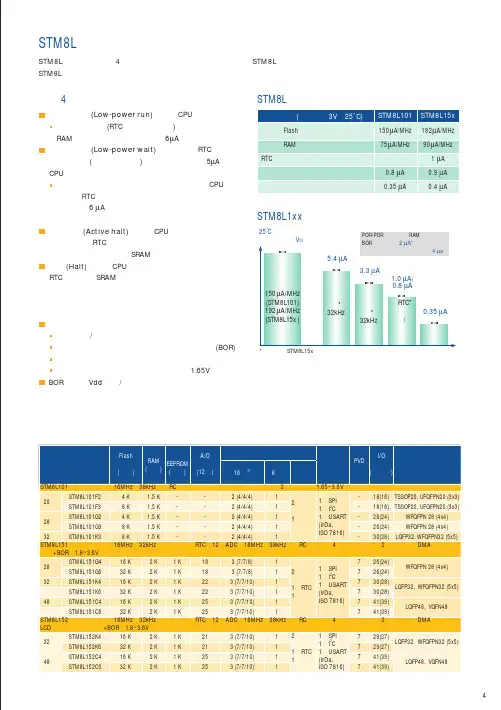
Enhanced Comparator (F9xx Products)Standard Comparator(All C8051 Products)Microcontroller ProductsSmall Form Factor Mixed-Signal MCUsMicrocontroller ProductsAutomotive Qualified MCUsAntennaAntenna Voice Commands Stereo OutExample Solution: Personal Navigation SystemSilicon Laboratories’ small footprint Audio and MCU solutions offer portable navigation device makers a comprehensive, full-featured solution for Traffic Messaging Channel (TMC), capacitive touch sense, FM transmit and LED control.Featured Devices • Si47xx Radio ICs • C8051 MCU• Si3000 Voice CodecCP2201EKC8051F340CP2201Si3400 2.3 STC11/10xx系列单片机选型一览表注意事项:STC11xx和STC10xx全系列都有一个独立波特率发生器,STC11xx和STC10xx系列的区别是:STC11xx比STC10xx系列多了一个掉电唤醒专用定时器STC11F05,STC11F05E,STC11L05,STC11L05E,IAP11F06,IAP11L06IAP11F62,IAP11F62X,IAP11L62,IAP11L62X 在下载用户程序时,需 将P1.0/P1.1短接到地,同时需使用外部时钟才可下载用户程序 STC11xx系列单片机选型一览表 型 号工作电压(V)Flash 程序存储器字节SRAM字节EEPROM定时器T0T1UART串口有独立波特率发生器DPTR中断优先级内部低压中断支持掉电唤醒外部中断掉电唤醒专用定时器内置复位并可选择复位门槛电压看门狗封装16-Pin12个I/O封装18-Pin14个I/O封装20-Pin16 个I/OSTC11Fxx系列单片机选型一览STC11F015.5 - 4.1/3.51K256-有1-2个12有5个有有有SOP/DIPSOP/DIPSOP/DIPSTC11F025.5 - 4.1/3.52K256-有1-2个12有5个有有有SOP/DIPSOP/DIPSOP/DIPSTC11F035.5 - 4.1/3.53K256-有1-2个12有5个有有有SOP/DIPSOP/DIPSOP/DIPSTC11F045.5 - 4.1/3.54K256-有1-2个12有5个有有有SOP/DIPSOP/DIPSOP/DIPSTC11F055.5 - 4.1/3.55K256-有1-2个12有5个有有有SOP/DIPSOP/DIPSOP/DIPIAP11F065.5 - 4.1/3.56K256-有1-2个12有5个有有有可在程序区修改程序区STC11F01E5.5 - 4.1/3.51K2562K有1-2个12有5个有有有SOP/DIPSOP/DIPSOP/DIPSTC11F02E5.5 - 4.1/3.52K2562K有1-2个12有5个有有有SOP/DIPSOP/DIPSOP/DIPSTC11F03E5.5 - 4.1/3.53K2562K有1-2个12有5个有有有SOP/DIPSOP/DIPSOP/DIPSTC11F04E5.5 - 4.1/3.54K2561K有1-2个12有5个有有有SOP/DIPSOP/DIPSOP/DIPSTC11F05E5.5 - 4.1/3.55K2561K有1-2个12有5个有有有需P1.0/P1.1 = 0/0和外部时钟才可以下载用户程序STC11Lxx系列单片机选型一览 型 号工作电压(V)Flash 程序存储器字节SRAM字节EEPROM定时器T0T1UART串口有独立波特率发生器DPTR中断优先级内部低压中断支持掉电唤醒外部中断掉电唤醒专用定时器内置复位并可选择复位门槛电压看门狗封装16-Pin12个I/O封装18-Pin14个I/O封装20-Pin16 个I/OSTC11L013.6 - 2.4/2.11K256-有1-2个12有5个有有有SOP/DIPSOP/DIPSOP/DIPSTC11L023.6 - 2.4/2.12K256-有1-2个12有5个有有有SOP/DIPSOP/DIPSOP/DIPSTC11L033.6 - 2.4/2.13K256-有1-2个12有5个有有有SOP/DIPSOP/DIPSOP/DIPSTC11L043.6 - 2.4/2.14K256-有1-2个12有5个有有有SOP/DIPSOP/DIPSOP/DIPSTC11L053.6 - 2.4/2.15K256-有1-2个12有5个有有有SOP/DIPSOP/DIPSOP/DIPIAP11L063.6 - 2.4/2.16K256-有1-2个12有5个有有有可在程序区修改程序区STC11L01E3.6 - 2.4/2.11K2562K有1-2个12有5个有有有SOP/DIPSOP/DIPSOP/DIPSTC11L02E3.6 - 2.4/2.12K2562K有1-2个12有5个有有有SOP/DIPSOP/DIPSOP/DIPSTC11L03E3.6 - 2.4/2.13K2562K有1-2个12有5个有有有SOP/DIPSOP/DIPSOP/DIPSTC11L04E3.6 - 2.4/2.14K2561K有1-2个12有5个有有有SOP/DIPSOP/DIPSOP/DIPSTC11L05E3.6 - 2.4/2.15K2561K有1-2个12有5个有有有需P1.0/P1.1 = 0/0和外部时钟才可以下载用户程序 型 号工作电压(V)Flash 程序存储器字节SRAM字节EEPROM定时器T0T1UART串口有独立波特率发生器DPTR中断优先级内部低压中断支持掉电唤醒外部中断掉电唤醒专用定时器内置复位并可选择复位门槛电压看门狗封装40-Pin36个I/O封装44-Pin40个I/OSTC11Fxx系列单片机选型一览STC11F60XE5.5 - 4.1/3.760K12801K有1-2个22有5个有有有PDIPLQFP/PLCCSTC11F56XE5.5 - 4.1/3.756K12805K有1-2个22有5个有有有PDIPLQFP/PLCCSTC11F52XE5.5 - 4.1/3.752K12809K有1-2个22有5个有有有PDIPLQFP/PLCCSTC11F48XE5.5 - 4.1/3.748K128013K有1-2个22有5个有有有PDIPLQFP/PLCCSTC11F40XE5.5 - 4.1/3.740K128021K有1-2个22有5个有有有PDIPLQFP/PLCCSTC11F32XE5.5 - 4.1/3.732K128029K有1-2个22有5个有有有PDIPLQFP/PLCCSTC11F20XE5.5 - 4.1/3.720K128029K有1-2个22有5个有有有PDIPLQFP/PLCCSTC11F16XE5.5 - 4.1/3.716K128032K有1-2个22有5个有有有PDIPLQFP/PLCCSTC11F08XE5.5 - 4.1/3.78K128032K有1-2个22有5个有有有PDIPLQFP/PLCCSTC11F60X5.5 - 4.1/3.760K1280-有1-2个22有5个有有有PDIPLQFP/PLCCSTC11F56X5.5 - 4.1/3.756K1280-有1-2个22有5个有有有PDIPLQFP/PLCCSTC11F52X5.5 - 4.1/3.752K1280-有1-2个22有5个有有有PDIPLQFP/PLCCSTC11F48X5.5 - 4.1/3.748K1280-有1-2个22有5个有有有PDIPLQFP/PLCCSTC11F40X5.5 - 4.1/3.740K1280-有1-2个22有5个有有有PDIPLQFP/PLCCSTC11F32X5.5 - 4.1/3.732K1280-有1-2个22有5个有有有PDIPLQFP/PLCCSTC11F20X5.5 - 4.1/3.720K1280-有1-2个22有5个有有有PDIPLQFP/PLCCSTC11F16X5.5 - 4.1/3.716K1280-有1-2个22有5个有有有PDIPLQFP/PLCCSTC11F08X5.5 - 4.1/3.78K1280-有1-2个22有5个有有有PDIPLQFP/PLCCIAP11F62X5.5 - 4.1/3.762K1280有1/222有5个有有有可在程序区修改程序区STC11F605.5 - 4.1/3.760K256-有1-2个22有5个有有有PDIPLQFP/PLCCSTC11F565.5 - 4.1/3.756K256-有1-2个22有5个有有有PDIPLQFP/PLCCSTC11F525.5 - 4.1/3.752K256-有1-2个22有5个有有有PDIPLQFP/PLCCSTC11F485.5 - 4.1/3.748K256-有1-2个22有5个有有有PDIPLQFP/PLCCSTC11F405.5 - 4.1/3.740K256-有1-2个22有5个有有有PDIPLQFP/PLCCSTC11F325.5 - 4.1/3.732K256-有1-2个22有5个有有有PDIPLQFP/PLCCSTC11F205.5 - 4.1/3.720K256-有1-2个22有5个有有有PDIPLQFP/PLCCSTC11F165.5 - 4.1/3.716K256-有1-2个22有5个有有有PDIPLQFP/PLCCSTC11F085.5 - 4.1/3.78K256-有1-2个22有5个有有有PDIPLQFP/PLCCIAP11F625.5 - 4.1/3.762K256-有1/222有5个有有有可在程序区修改程序区STC11Fxx系列单片机选型一览表注意事项:STC11xx和STC10xx全系列都有一个独立波特率发生器,STC11xx和STC10xx系列的区别是:STC11xx比STC10xx系列多了一个掉电唤醒专用定时器STC11F05,STC11F05E,STC11L05,STC11L05E,IAP11F06,IAP11L06IAP11F62,IAP11F62X,IAP11L62,IAP11L62X 在下载用户程序时, 型 号工作电压(V)Flash 程序存储器字节SRAM字节EEPROM定时器T0T1UART串口有独立波特率发生器DPTR中断优先级内部低压中断支持掉电唤醒外部中断掉电唤醒专用定时器内置复位并可选择复位门槛电压看门狗封装40-Pin36个I/O封装44-Pin40个I/OSTC11Fxx系列单片机选型一览STC11L60XE3.6 - 2.4/2.160K12801K有1-2个22有5个有有有PDIPLQFP/PLCCSTC11L56XE3.6 - 2.4/2.156K12805K有1-2个22有5个有有有PDIPLQFP/PLCCSTC11L52XE3.6 - 2.4/2.152K12809K有1-2个22有5个有有有PDIPLQFP/PLCCSTC11L48XE3.6 - 2.4/2.148K128013K有1-2个22有5个有有有PDIPLQFP/PLCCSTC11L40XE3.6 - 2.4/2.140K128021K有1-2个22有5个有有有PDIPLQFP/PLCCSTC11L32XE3.6 - 2.4/2.132K128029K有1-2个22有5个有有有PDIPLQFP/PLCCSTC11L20XE3.6 - 2.4/2.120K128029K有1-2个22有5个有有有PDIPLQFP/PLCCSTC11L16XE3.6 - 2.4/2.116K128032K有1-2个22有5个有有有PDIPLQFP/PLCCSTC11L08XE3.6 - 2.4/2.18K128032K有1-2个22有5个有有有PDIPLQFP/PLCCSTC11L60X3.6 - 2.4/2.160K1280-有1-2个22有5个有有有PDIPLQFP/PLCCSTC11L56X3.6 - 2.4/2.156K1280-有1-2个22有5个有有有PDIPLQFP/PLCCSTC11L52X3.6 - 2.4/2.152K1280-有1-2个22有5个有有有PDIPLQFP/PLCCSTC11L48X3.6 - 2.4/2.148K1280-有1-2个22有5个有有有PDIPLQFP/PLCCSTC11L40X3.6 - 2.4/2.140K1280-有1-2个22有5个有有有PDIPLQFP/PLCCSTC11L32X3.6 - 2.4/2.132K1280-有1-2个22有5个有有有PDIPLQFP/PLCCSTC11L20X3.6 - 2.4/2.120K1280-有1-2个22有5个有有有PDIPLQFP/PLCCSTC11L16X3.6 - 2.4/2.116K1280-有1-2个22有5个有有有PDIPLQFP/PLCCSTC11L08X3.6 - 2.4/2.18K1280-有1-2个22有5个有有有PDIPLQFP/PLCCIAP11L62X3.6 - 2.4/2.162K1280有1/222有5个有有有可在程序区修改程序区STC11L603.6 - 2.4/2.160K256-有1-2个22有5个有有有PDIPLQFP/PLCCSTC11L563.6 - 2.4/2.156K256-有1-2个22有5个有有有PDIPLQFP/PLCCSTC11L523.6 - 2.4/2.152K256-有1-2个22有5个有有有PDIPLQFP/PLCCSTC11L483.6 - 2.4/2.148K256-有1-2个22有5个有有有PDIPLQFP/PLCCSTC11L403.6 - 2.4/2.140K256-有1-2个22有5个有有有PDIPLQFP/PLCCSTC11L323.6 - 2.4/2.132K256-有1-2个22有5个有有有PDIPLQFP/PLCCSTC11L203.6 - 2.4/2.120K256-有1-2个22有5个有有有PDIPLQFP/PLCCSTC11L163.6 - 2.4/2.116K256-有1-2个22有5个有有有PDIPLQFP/PLCCSTC11L083.6 - 2.4/2.18K256-有1-2个22有5个有有有PDIPLQFP/PLCCIAP11L623.6 - 2.4/2.162K256-有1/222有5个有有有可在程序区修改程序区注意事项:STC11xx和STC10xx全系列都有一个独立波特率发生器,STC11xx和STC10xx系列的区别是:STC11xx比STC10xx系列多了一个掉电唤醒专用定时器STC11F05,STC11F05E,STC11L05,STC11L05E,IAP11F06,IAP11L06IAP11F62,IAP11F62X,IAP11L62,IAP11L62X 在下载用户程序时, 型 号工作电压(V)Flash 程序存储器字节SRAM字节EEPROM定时器T0T1UART串口有独立波特率发生器DPTR中断优先级内部低压中断支持掉电唤醒外部中断掉电唤醒专用定时器内置复位并可选择复位门槛电压看门狗封装40-Pin36个I/O封装44-Pin40个I/OSTC10Fxx系列单片机选型一览STC10F025.5 - 3.8/3.32K256-有1-2个22有5个-有有PDIPLQFP/PLCCSTC10F02X5.5 - 3.8/3.32K512-有1-2个22有5个-有有PDIPLQFP/PLCCSTC10F02XE5.5 - 3.8/3.32K512 5K有1-2个22有5个-有有PDIPLQFP/PLCCSTC10F045.5 - 3.8/3.34K256-有1-2个22有5个-有有PDIPLQFP/PLCCSTC10F04X5.5 - 3.8/3.34K512-有1-2个22有5个-有有PDIPLQFP/PLCCSTC10F04XE5.5 - 3.8/3.34K512 5K有1-2个22有5个-有有PDIPLQFP/PLCCSTC10F065.5 - 3.8/3.36K256-有1-2个22有5个-有有PDIPLQFP/PLCCSTC10F06X5.5 - 3.8/3.36K512-有1-2个22有5个-有有PDIPLQFP/PLCCSTC10F06XE5.5 - 3.8/3.36K512 5K有1-2个22有5个-有有PDIPLQFP/PLCCSTC10F085.5 - 3.8/3.38K256-有1-2个22有5个-有有PDIPLQFP/PLCCSTC10F08X5.5 - 3.8/3.38K512-有1-2个22有5个-有有PDIPLQFP/PLCCSTC10F08XE5.5 - 3.8/3.38K512 5K有1-2个22有5个-有有PDIPLQFP/PLCCSTC10F105.5 - 3.8/3.310K256-有1-2个22有5个-有有PDIPLQFP/PLCCSTC10F10X5.5 - 3.8/3.310K512-有1-2个22有5个-有有PDIPLQFP/PLCCSTC10F10XE5.5 - 3.8/3.310K512 3K有1-2个22有5个-有有PDIPLQFP/PLCCSTC10F125.5 - 3.8/3.312K256-有1-2个22有5个-有有PDIPLQFP/PLCCSTC10F12X5.5 - 3.8/3.312K512-有1-2个22有5个-有有PDIPLQFP/PLCCSTC10F12XE5.5 - 3.8/3.312K512 1K有1-2个22有5个-有有PDIPLQFP/PLCCIAP10F145.5 - 3.8/3.314K512有1-2个22有5个-有有可在程序区修改程序区STC10Lxx系列单片机选型一览 型 号工作电压(V)Flash 程序存储器字节SRAM字节EEPROM定时器T0T1UART串口有独立波特率发生器DPTR中断优先级内部低压中断支持掉电唤醒外部中断掉电唤醒专用定时器内置复位并可选择复位门槛电压看门狗封装40-Pin36个I/O封装44-Pin40个I/OSTC10L023.6- 2.4/2.12K256-有1-2个22有5个-有有PDIPLQFP/PLCCSTC10L02X3.6- 2.4/2.12K512-有1-2个22有5个-有有PDIPLQFP/PLCCSTC10L02XE3.6- 2.4/2.12K512 5K有1-2个22有5个-有有PDIPLQFP/PLCCSTC10L043.6- 2.4/2.14K256-有1-2个22有5个-有有PDIPLQFP/PLCCSTC10L04X3.6- 2.4/2.14K512-有1-2个22有5个-有有PDIPLQFP/PLCCSTC10L04XE3.6- 2.4/2.14K512 5K有1-2个22有5个-有有PDIPLQFP/PLCCSTC10L063.6- 2.4/2.16K256-有1-2个22有5个-有有PDIPLQFP/PLCCSTC10L06X3.6- 2.4/2.16K512-有1-2个22有5个-有有PDIPLQFP/PLCCSTC10L06XE3.6- 2.4/2.16K512 5K有1-2个22有5个-有有PDIPLQFP/PLCCSTC10L083.6- 2.4/2.18K256-有1-2个22有5个-有有PDIPLQFP/PLCCSTC10L08X3.6- 2.4/2.18K512-有1-2个22有5个-有有PDIPLQFP/PLCCSTC10L08XE3.6- 2.4/2.18K512 5K有1-2个22有5个-有有PDIPLQFP/PLCCSTC10L103.6- 2.4/2.110K256-有1-2个22有5个-有有PDIPLQFP/PLCCSTC10L10X3.6- 2.4/2.110K512-有1-2个22有5个-有有PDIPLQFP/PLCCSTC10L10XE3.6- 2.4/2.110K512 3K有1-2个22有5个-有有PDIPLQFP/PLCCSTC10L123.6- 2.4/2.112K256-有1-2个22有5个-有有PDIPLQFP/PLCCSTC10L12X3.6- 2.4/2.112K512-有1-2个22有5个-有有PDIPLQFP/PLCCSTC10L12XE3.6- 2.4/2.112K512 1K有1-2个22有5个-有有PDIPLQFP/PLCC 型 号工作电压(V)Flash 程序存储器字节SRAM字节EEPROM定时器T0T1UART串口有独立波特率发生器DPTR中断优先级内部低压中断支持掉电唤醒外部中断掉电唤醒专用定时器内置复位并可选择复位门槛电压看门狗封装40-Pin36个I/O封装44-Pin40个I/OSTC11F60XE系列单片机选型一览(另有3V低压系列单片机可供选择)STC11F60XE5.5 - 4.1/3.760K12801K有1-2个22有5个有有有PDIP/QFNLQFP/PLCCSTC11F56XE5.5 - 4.1/3.756K12805K有1-2个22有5个有有有PDIP/QFNLQFP/PLCCSTC11F52XE5.5 - 4.1/3.752K12809K有1-2个22有5个有有有PDIP/QFNLQFP/PLCCSTC11F48XE5.5 - 4.1/3.748K128013K有1-2个22有5个有有有PDIP/QFNLQFP/PLCCSTC11F40XE5.5 - 4.1/3.740K128021K有1-2个22有5个有有有PDIP/QFNLQFP/PLCCSTC11F32XE5.5 - 4.1/3.732K128029K有1-2个22有5个有有有PDIP/QFNLQFP/PLCCSTC11F20XE5.5 - 4.1/3.720K128029K有1-2个22有5个有有有PDIP/QFNLQFP/PLCCSTC11F16XE5.5 - 4.1/3.716K128032K有1-2个22有5个有有有PDIP/QFNLQFP/PLCCSTC11F08XE5.5 - 4.1/3.78K128032K有1-2个22有5个有有有PDIP/QFNLQFP/PLCCIAP11F62X5.5 - 4.1/3.762K1280 IAP有1-2个22有5个有有有可在程序区修改程序区需P1.0/P1.1 = 0/0和外部时钟才可以下载用户程序(无ID号)STC10Fxx系列单片机选型一览(另有3V低压系列单片机可供选择)STC10F045.5 - 3.8/3.34K256-有1-2个22有5个-有有PDIP/QFNLQFP/PLCCSTC10F04XE5.5 - 3.8/3.34K512 5K有1-2个22有5个-有有PDIP/QFNLQFP/PLCCSTC10F085.5 - 3.8/3.38K256-有1-2个22有5个-有有PDIP/QFNLQFP/PLCCSTC10F08XE5.5 - 3.8/3.38K512 5K有1-2个22有5个-有有PDIP/QFNLQFP/PLCCSTC10F125.5 - 3.8/3.312K256-有1-2个22有5个-有有PDIP/QFNLQFP/PLCCSTC10F12XE5.5 - 3.8/3.312K512 1K有1-2个22有5个-有有PDIP/QFNLQFP/PLCCIAP10F14X5.5 - 3.8/3.314K512 IAP有1-2个22有5个-有有可在程序区修改程序区需P1.0/P1.1 = 0/0和外部时钟才可以下载用户程序(无ID号)宏晶采用最新第六代加密技术的STC11F/10Fxx系列单片机选型一览表直接取代全球各厂家均已被解密的89系列单片机 型 号工作电压(V)Flash 程序存储器字节SRAM字节EEPROM定时器T0T1UART串口有独立波特率发生器DPTR中断优先级内部低压中断支持掉电唤醒外部中断掉电唤醒专用定时器内置复位并可选择复位门槛电压看门狗封装14-Pin10个I/O封装16-Pin12个I/O封装18-Pin14个I/O封装20-Pin16 个I/OSTC11F02E系列单片机选型一览(另有3V低压系列单片机可供选择,并且有STC11F02系列不带内部EEPROM,价格更低)STC11F01E5.5 - 4.1/3.51K2562K有1-2个12有5个有有有LSSOPSOP/DIPSOP/DIPSOP/DIPSTC11F02E5.5 - 4.1/3.52K2562K有1-2个12有5个有有有LSSOPSOP/DIPSOP/DIPSOP/DIPSTC11F03E5.5 - 4.1/3.53K2562K有1-2个12有5个有有有LSSOPSOP/DIPSOP/DIPSOP/DIPSTC11F04E5.5 - 4.1/3.54K2561K有1-2个12有5个有有有LSSOPSOP/DIPSOP/DIPSOP/DIPSTC11F05E5.5 - 4.1/3.55K2561K有1-2个12有5个有有有LSSOP需P1.0/P1.1 = 0/0和外部时钟才可以下载用户程序IAP11F065.5 - 4.1/3.56K256IAP有1-2个12有5个有有有LSSOP可在程序区修改程序区需P1.0/P1.1 = 0/0和外部时钟才可以下载用户程序以上只列举了STC11/10xx系列部分5伏型号,3V单片机型号请参阅STC11/10xx系列单片机用户手册,更多型号请登陆宏晶科技官方网站 www.STCMCU.com 下载更多资料,STC11xx系列和STC10xx系列的区别是:STC11xx系列比STC10xx系列多了掉电唤醒专用定时器。
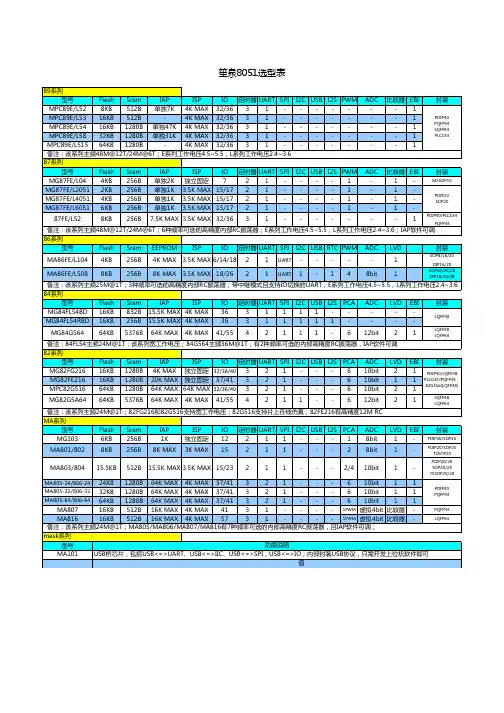

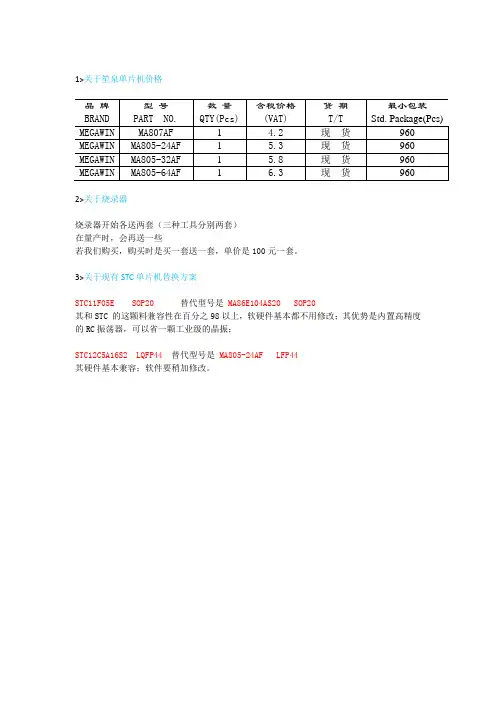
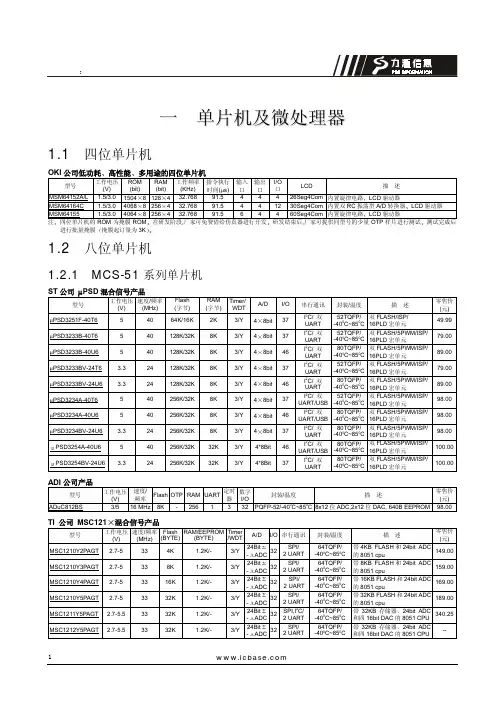


8051 ISP(U2) 烧录器用户指南V7.03目录1简介 (2)2使用ISP功能前必须的芯片配置 (3)3安装ISP(U2)烧录器 (4)3.1安装驱动程序 (4)3.2安装应用程序 (4)4使用ISP(U2)烧录器 (5)4.1下载烧录数据到ISP(U2)烧录器 (5)4.1.1步骤一:选择你要的“单片机型号” (5)4.1.2步骤二:点击“载入文件”,HEX和BIN,MPJ格式都可以。
(5)4.1.3步骤三:配置硬件选项(仅MPC89/MG82系列有效) (6)4.1.4步骤四:“设置脱机模式” (8)4.2更新目标芯片 (9)4.2.1方法一: 点击“更新目标芯片”进行联机更新 (9)4.2.1方法二: 按烧录器的“开始按键”进行脱机更新 (9)4.3读取信息区的内容 (9)4.3.1步骤一:选择你要的“单片机型号” (9)4.3.2步骤二:点击“读取信息区”,来读取内容 (9)4.4笙泉项目文件(MPJ文件) (10)4.4.1保存一个MPJ文件 (10)4.4.2加载一个MPJ文件 (11)5信息区域 (12)5.1信息区域的设定 (12)5.2读取信息区域的内容 (13)6特別注意 (14)7关于信息 (15)8关于自动重载代码 (17)9版本历史 (18)1 简介ISP 是”I n-S ystem P rogramming ”的缩写。
可使用户通过软件来更新用户程序,而不必从产品中取下芯片来。
”8051 ISP(U2) 烧录器”工具(见下图)。
因为可以将用户程序存储到烧录器里的非易失性记忆体里,所以这烧录器可以进行脱机烧录(不用连接到电脑), 非常适用与没有电脑的地方。
8051 ISP 烧录器图片8051 U2 烧录器图片绿灯 开始按键 红灯 12 34ISP 接口 4: 不接 3: VCC 2: DTA 1: GND USB 灯 USB 接口2使用ISP功能前必须的芯片配置为了能使用ISP功能,用户应当在“Megawin 8051 Writer”或“Megawin 8051 Writer U1”里使用“插入ISP代码”来配置目标MCU,并且设置ISP 空间为1KB(对于MPC82L(E)54是1.5KB)和确认HWBS 或HWBS2选项使能注意:为了用户更容易使用ISP功能,笙泉8051系列MCU在出厂时已经做下列出厂设置,即:1)ISP空间设置成1K(或1.5K),并且”HWBS”选项使能2)预烧录笙泉提供的标准ISP-code.因此,用户不必在使用ISP功能之前对芯片进行配置****更多信息请联系笙泉3安装ISP(U2)烧录器3.1安装驱动程序将ISP(U2) 烧录器连接到电脑的USB口,当电脑弹出提示框显示发现新硬件时,按以下步骤操作。
与8051兼容的单片机及其应用选型一、引言在世界上8位单片机诞生后不久,8051的出现了,由于8051在当时8位单片机中的突出性能,它成为事实上的工业标准。
由于Intel公司的技术开放和8051的经典体系结构、良好的兼容性,众多的半导体厂商都热衷于8051及其兼容单片机的发展,特别是近几年来,随着微电子技术与计算机技术的迅猛发展,8051及其兼容单片机的发展日新月异、品种繁多,令人目不暇接。
8051及其兼容单片机的生产厂商各施绝技,生产出各具特色的8051及其兼容单片机,概括说来,新型的8051及其兼容单片机有如下的特点或功能:1.高速度;2.混合(模拟与数字)信号处理;3.低功耗;4.多时钟和实时时钟;5.大容量存储器;6.大数量的I/O口和多功能、可配置I/O口;7.基于串口或JTAG结构的在系统调试;8.多种复位源;9.片内可编程门阵列和系统可配置;10.多种串口;11.DMA功能;12.USB接口;13.视频(电视)信号处理与控制;14.网络接口;……由于与8051兼容的单片机品种繁多,限于篇幅,要在本文中介绍所有新型的与8051兼容单片机是不可能的,而要重点介绍若干个品种,既有难以取舍的窘迫,又有挂一漏万之嫌。
即使是仅介绍这些新型的单片机的特点,恐怕也难在一篇短文中叙述清楚。
作者只好把所收集的与8051兼容的单片机及其特点整理成表格,供大家在开发选型时参考。
应该说明的是,该表格不可能把所有的与8051兼容的单片机都收入到,所列特点也仅仅是概括性的,不可能把所有的技术指标都给列出。
二、与8051兼容的单片机下表列出了与8051兼容的单片机的生产公司、信号及其特点与主要技术指标。
三、结束语本文用列表的形式给出了与8051兼容的单片机的生产公司、信号及其特点与主要技术指标。
这些品种繁多、性能优异而又各具特色的新型单片机,为同行们开发新产品和改造已有产品提供了契机与方便。
相信本文能为读者提供极高的参考价值。
M IDYEAR U PDATE2006ToolStick Development PlatformThe USB ToolStick platform is a fully contained evaluation and development system in a USB stick that demonstrates Silicon Labs’ easy-to-use develop-ment tools. Using only a PC with a USB port, designers can fully experience the Silicon Labs software development environment in conjunction with the MCU on-chip debugging hardware that allows full, non-intrusive access to the CPU, peripherals and memory. Buy online at /ToolStickPrecision Mixed-Signal MCUsSmall Form Factor Mixed-Signal MCUsUSB Mixed-Signal MCUsEasily update legacy RS-232 and RS-485 designs to USB. The CP210x single-chip CP2103-EBBuy online at /USBEthernet802.15.4/ZigBee TM Development KitsSilicon Labs offers 802.15.4 and ZigBee development kits that allow customers to focus on application development rather than hardware selection. These kits include all the hardware and software needed to immediately begin developing 802.15.4 or ZigBee network solutions.•Demonstration GUI– Graphical representation of 13 ZigBee topologies– Three demo applications to monitor data from any of the networked devices: temperature, received signal strength indicator (RSSI) and thumbwheel (analog)•802.15.4 MAC-level application development •ZigBee application development•Silicon Labs Integrated Development Environment (IDE)Buy online at /ZigBeeZigBee-2.4-DKPower over Ethernet Voice Reference DesignThis reference design includes the PoE-VOICE-EB Reference Design Board which contains an IEEE 802.3af compliant Power over Ethernet circuit, 8 kHz voice/speech sampling system and an IEEE 802.3 embedded Ethernet connection. The board provides a hardware platform for evaluating and developing software for embedded systems that use the C8051F340 as the main controller, the CP2201 as the Ethernet controller and the Si3400as the PoE controller. The reference design software uses the TCP/IP Configuration Wizard,which generates starter firmware based on the industry standard CMX™ Micronet Stack.Buy online at /EthernetPoE-Voice-EBCAN Mixed-Signal MCUsCP2120 SPI-I 2C Bridge and GPIO Port ExpanderThe CP2120 allows an SPI master to communicate as an I 2C master device. The chip includes a 4-wire slave SPI bus, bridge control logic, a bi-directional I 2C bus interface and 8 general purpose input/output pins. The CP2120 Evaluation Kit demonstrates the SPI-I 2C fixed functionality and requires absolutely no code development. Buy online at /CP2120CP2120EKBuy Online 16 mm16 mm12 mm12 mm9 mm9 mm9 mm9 mm5 mm5 mm4 mm4 mm3 mm3 mm©2006, Silicon Laboratories Inc. Silicon Laboratories and the Silicon Labs logo are trademarks of Silicon Laboratories Inc. All other product or service names are the property of their perspective owners. PG, 5000, Oct 06 , Rev EMicrocontroller Development ToolsDevelopment KitsComplete development/prototyping system includes the following:•Prototyping/demonstration board• USB adapter for in-system programming and debugging • Silicon Laboratories IDE • MCU configuration wizard Buy online at /DevKitsIntegrated Development EnvironmentThird Party Tool SupportA broad range of third-party compilers and development tools are available, including a free Small Device C Compiler (SDCC) supported by App Note 198, “Integrating SDCC 8051 Tools into the Silicon Labs IDE.”Flash programming and source-level debug of OMF-51 object files is fully supported.Design Support at /MCUSilicon Laboratories ’Reference Designs, Application Notes and source code examples address a wide range of applications and markets. Visit our website at /MCU for complete access to all of our design resources.Product Support at /supportMCU User’s Forum: where C8051F MCU users can share experiences and technical questions with other users.Microcontroller support email: Americas:mcuapps@Europe and Asia:eumcuapps@Development Kit or IDE support email: mcutools@400 West Cesar Chavez Austin, TX 78701512.416.8500877.444.3032 (toll free)Fax: 512.416.96694 kB C compiler included Source code editor Project managerKeil 8051 macro assembler and linker Flash programmerSupports full-speed, non-intrusive, in-circuit debug logic Source-level debugVariable watch window Real-time breakpointsConditional memory watchpoints Memory and register inspect/modify Supports third-party development tools Single-step and animated execution modesPricing and availability: /sales6.5 mm6.5 mm。